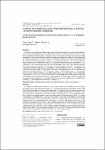Mostrar el registro sencillo del ítem
Cultivos de cobertura como antecesor de zapallo anco en la región semiárida pampeana
Cover Crops As Predecessor Of Pumpkin Crop In The Semiarid Pampa Region
| dc.contributor.author | Ponce, Juan | |
| dc.contributor.author | Siliquini, Oscar | |
| dc.contributor.author | Fernández, Romina | |
| dc.date.accessioned | 2020-11-03T00:25:57Z | |
| dc.date.available | 2020-11-03T00:25:57Z | |
| dc.date.issued | 2020 | |
| dc.identifier.uri | https://repo.unlpam.edu.ar/handle/unlpam/6621 | |
| dc.description.abstract | Se planteó como objetivo del trabajo determinar el efecto de los cultivos de cobertura en la eficiencia en el uso del agua y rendimiento total de del cultivo de zapallo. El estudio se desarrolló sobre un suelo denominado Paleustol petrocálcico, ubicado en el sur de la planicie con tosca de la región semiárida pampeana. En el mismo lote durante tres temporadas consecutivas, se sembraron como tratamiento de cobertura Centeno (C), Centeno + Vicia (C V) y barbecho sin cultivo de cobertura. De esta manera se conformaron 6 tratamientos de manejo para el cultivo de zapallo: T1: sin antecesor CC con labranzas previas a la siembra del zapallo, y sin control de malezas durante el ciclo zapallo. T 2: sin antecesor CC con labranzas previas a la siembra del Zapallo, con control de malezas (laboreo y herbicida), durante el ciclo zapallo. C H: Antecesor Centeno utilizado como CC, con detención del crecimiento mediante herbicida. C R: Antecesor Centeno utilizado como CC, con detención del crecimiento mediante rolado. CV H: Antecesor Centeno + Vicia utilizado como CC, con detención del crecimiento mediante herbicida. CV R: Antecesor Centeno + Vicia utilizado como CC, con detención del crecimiento mediante rolado. Los resultados demostraron que en promedio en las 3 temporadas C fue superior a C V, en 22, 19 y 6% con respecto a la biomasa total, para la primera, segunda y tercera temporada, respectivamente. Los cultivos de cobertura tuvieron mayor eficiencia de barbecho con respecto a los tratamientos sin CC previo (T1 y T2). Los mayores rendimientos de zapallo fueron sobre los CC, siendo estos los de menor UC y mayor EUA. | |
| dc.description.abstract | The objective was determine the effect of cover crops on the water use efficiency and total yield of the pumpkin crop. The study was carried out on a soil called petrocalcic Paleustoll, located in the south of the rugged plain of the semiarid Pampa region. In the same lot for three consecutive seasons, Rye (C) and rye + vetch (CV) were sown and fallow was established without cover cultivation. In this way, 6 management treatments for pumpkin cultivation were established: T1: without CC predecessor, with tillage prior to pumpkin planting, and without weed control during the pumpkin cycle. T 2: without predecessor CC with tillage prior to planting the pumpkin, with weed control (tillage and herbicide), during the pumpkin cycle. C H: Rye ancestor used as CC, with growth arrest by herbicide. C R: Rye ancestor used as CC, with growth arrest by rolling. CV H: Rye + Vetch ancestor used as CC, with growth arrest by herbicide. CV R: Rye + Vetch ancestor used as CC, with growth arrest by rolling. The results showed that on average in the 3 seasons C was higher than C V, in 22, 19 and 6% with respect to the total biomass, for the first, second and third seasons, respectively. Cover crops had higher fallow efficiency with respect to treatments without prior CC (T1 and T2). The highest pumpkin yields were over the CC, these being the ones with the lowest UC and the highest EUAt | |
| dc.format.extent | p. 51-61 | |
| dc.format.medium | application/pdf | |
| dc.language.iso | spa | |
| dc.rights | Atribución-NoComercial-CompartirIgual 2.5 Argentina (CC BY-NC-SA 2.5 AR) | |
| dc.rights.uri | https://creativecommons.org/licenses/by-nc-sa/2.5/ar/ | |
| dc.source.uri | https://repo.unlpam.edu.ar/handle/unlpam/5690 | |
| dc.title | Cultivos de cobertura como antecesor de zapallo anco en la región semiárida pampeana | |
| dc.title | Cover Crops As Predecessor Of Pumpkin Crop In The Semiarid Pampa Region | |
| dc.type | artículo | |
| dc.unlpam.doi | http://dx.doi.org/10.19137/semiarida.2020(02).51-61 | |
| dc.unlpam.instituciondeorigen | Facultad de Agronomía | |
| dc.unlpam.seccion | Artículos Científicos y Técnicos | |
| dc.unlpam.access | openAccess | |
| dc.unlpam.version | acceptedVersion | |
| dc.unlpam.filiacion | Ponce, Juan P.. Universidad Nacional de La Pampa. Facultad de Agronomía, Santa Rosa; Argentina | |
| dc.unlpam.filiacion | Siliquini, Oscar A.. Universidad Nacional de La Pampa. Facultad de Agronomía, Santa Rosa; Argentina | |
| dc.unlpam.filiacion | Fernández, Romina. Instituto Nacional de Tecnología Agropecuaria, Santa Rosa; Argentina | |
| dc.subject.keyword | no tillage, water content, fallow, rye, vetch, squash | |
| dc.subject.palabraclave | siembra directa | |
| dc.subject.palabraclave | contenido de agua | |
| dc.subject.palabraclave | barbecho | |
| dc.subject.palabraclave | centeno | |
| dc.subject.palabraclave | vicia | |
| dc.subject.palabraclave | zapallo | |
| dc.source.revistaunlpam | Semiárida: Revista de la Facultad de Agronomía. 2020; vol.30 no.2 |
Ficheros en el ítem
Este ítem aparece en la(s) siguiente(s) colección(ones)
-
Semiárida : revista de la Facultad de Agronomía [816]
Revista científica semestral de la Facultad de Agronomía, UNLPam.











